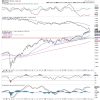
One the goals of our ongoing Defending Globalization project is to challenge prevailing misconceptions about the global economy, and newly‐released data on inflation‐adjusted US trade in goods give us two new examples.
First, the data continue to show that, for all the protectionist talk and policy coming out of Washington these days and all the bold pandemic‐era predictions of “de‐globalization,” actual American companies and consumers aren’t really buying it. In fact, inflation‐adjusted US trade in goods (imports and exports) last year was right off its 2022 record high—even as the Biden administration leaned into Trump‐era US protectionism (which targets goods, not services), as post‐pandemic Americans shifted their consumption back towards services (thus potentially limiting goods imports), and as economies in Europe and Asia struggled (thus potentially limiting US goods exports).
Steadily increasing US goods trade flows have put the $4.4 trillion total above pre‐pandemic levels and far, far above those seen during the supposed “hyperglobalization” heyday of the 1990s and 2000s.
These data once again show how globalization is driven by people, not governments, and how talk about the United States’ turn inward remains primarily a political, not economic, phenomenon. Maybe that latter point changes in the years ahead, but so far there’s little sign of it.
Second, the same dataset reiterates the prevailing view among economists that tariffs and other protectionist policies won’t reduce the US trade deficit, which is driven not by those and other trade policies but seismic macroeconomic factors. Leaving aside for the moment the fact that the trade deficit (especially for just goods) isn’t an economic problem to be solved, we see again in 2023 that Trump‐Biden efforts to increase tariffs, Buy American mandates, localization subsidies, and supply chain “resiliency” initiatives—which again target goods, not services—have done little to change the general downward trajectory of the US goods trade balance since the 1990s.
Thus, while the US‐China trade deficit declined last year, bilateral deficits with other countries “soared to new highs.” (Notably, the only thing that did substantially, albeit temporarily, alter the goods deficit’s long‐term trajectory was the Great Recession—hardly something we want to repeat.)
In the coming months, we’re sure to hear plenty from campaigning politicians about tariffs, the trade deficit, and US trade policy more broadly. As these two examples (and many others) indicate, much of what’s said will be misleading, if not outright wrong. While we shouldn’t expect such facts to intrude on the campaigns’ own messaging, that doesn’t mean the rest of us should play along.





















